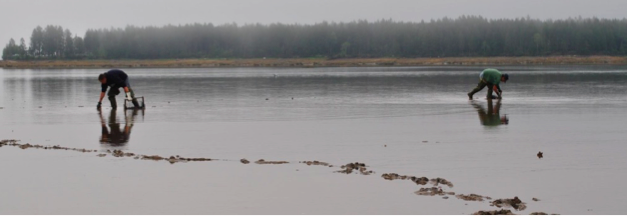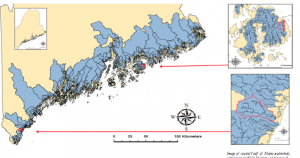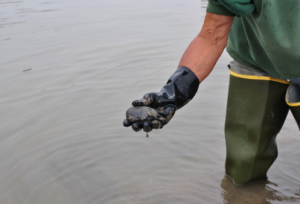30 December 2015
Scientists develop new tools to anticipate coastal pollution in Maine
Posted by Lauren Lipuma
by Amy McDermott

Fishermen harvest clams in a coastal mudflat in Maine. Credit: Bridie McGreavy, University of Maine.
In Maine, leaking sewers and failing septic systems, upstream beaver dams, animal waste, and agricultural runoff can easily contaminate coastal watersheds. When heavy rains wash a deluge of those pollutants down coastal streams and out to sea, the contamination can bring the state’s economy to a standstill: two inches of rain is enough to close beaches and shellfish fisheries, following guidelines set by the Clean Water Act. But not every beach is as easily fouled, researchers say, and it may be better to manage watershed closures individually.

The Gulf of Maine’s coastal watersheds, with insets of Wells Harbor and Cromwell Brook watersheds.
Credit: Abigail Bradford, University of Maine.
Scientists from the University of Maine, University of New Hampshire, and College of the Atlantic have now designed a new way to predict fine-scale watershed contamination along Maine’s coast. Their work will inform watershed management throughout the state and ultimately other coastal areas, said Sean Smith, a watershed geomorphologist at the University of Maine who presented the project at the 2015 American Geophysical Union Fall Meeting.
Maine’s coast is a long, jagged stretch of bays, inlets and fragmented islands. Small fishing towns fringe the Atlantic, nestled against thick temperate forests. Tourists descend on the beaches in summer, while fishermen haul in lobster, crab, and clams year-round. Maine depends on those connections between land and sea: together, coastal recreation and shellfishing contribute about $420 million to its economy every year.
Each watershed along the coast is different, however, and local and state governments need guidance on when beach and shellfish closures should be put in place and how long they should last, Smith said. The way contaminants are delivered (from a web of spidery streams or one surging river), the speed they reach the sea, and the amount of time they linger in the water should all inform management decisions as well, he added.

Fishermen harvest clams in a coastal mudflat in Maine. Credit: Bridie McGreavy, University of Maine.
To make better contamination projections, the team created a new, high-resolution topographic map of the whole coast of Maine. The map delineates the boundaries of watersheds and their drainage networks to predict the amount of fresh water injecting bacteria into estuaries, Smith said.
They also measured water flow, bacterial contamination, and total suspended solids at two sites, Bar Harbor in the north and Wells Harbor in the south, to look for correlations between rainfall and bacteria and to calibrate existing models, Smith said. The researchers categorized coastal watersheds based on similarities in bacterial sources, delivery, and residence time.
They found that watersheds near human populations are more vulnerable to contamination by dangerous bacteria. Development creates more sources of contamination, and man-made storm drains and swales make natural drainage networks more efficient, so bacteria moves more quickly from source to sink, Smith explained. Some estuaries are also flushed out more often than others: their size and shape influence the rate of water exchanged as tides come in and out and the amount of time that bacteria lingers in the area, he said.
Ultimately, the team hopes to build a prediction system customized to individual communities—one that accounts for toxin sources, delivery, and duration in Maine’s watersheds. According to Smith, understanding how hydrology and pollution interact will help managers understand which factors are most influential and mitigate their consequences in the future.
‑ Amy McDermott is a graduate student in the Science Communication program at UC Santa Cruz. Follow her on Twitter at @amygmcdermott.










 GeoSpace is a blog on Earth and space science, managed by AGU’s Public Information staff. The blog features posts by AGU writers and guest contributors on all sorts of relevant science topics, but with a focus on new research and geo and space sciences-related stories that are currently in the news.
GeoSpace is a blog on Earth and space science, managed by AGU’s Public Information staff. The blog features posts by AGU writers and guest contributors on all sorts of relevant science topics, but with a focus on new research and geo and space sciences-related stories that are currently in the news.